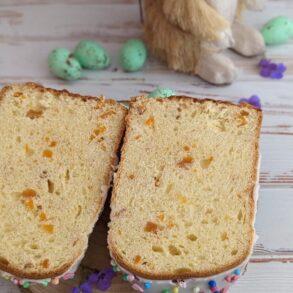Dieser Beitrag ist auch verfügbar auf:
Deutsch
Thanks to the quark yeast dough, this Russian sweet Easter bread tastes heavenly moist and fluffy at the same time. Lemon zest gives it a special flavor. The quark Easter bread is also an eye-catcher on the dining table and perfect for giving as a gift at Easter. A detailed kulich with quark recipe with exact quantities and step-by-step instructions can be found here at the bottom.

Moist quark yeast dough
The dough that makes this kulich is not a classic yeast dough. It is prepared with quark.
This makes the Russian Easter bread taste heavenly moist in the end. At the same time, just like the classic kulich, it is airy and light.
Thanks to lemon zest, the quark kulich is also very aromatic.
Use any dried fruit
I made the Russian quark Easter bread with soft apricots and, just like my puff pastry kulich with crumble, with candied orange peel. Alternatively, you can use other dried fruits. Raisins, for example, are very popular for this purpose. Instead of candied orange peel you can also use candied lemon peel. Or use any candied fruit of your choice.
You can also experiment with the amount of dried and candied fruits. But don’t overdo it, otherwise the yeast dough will have a hard time rising.

Baking pan for kulich with quark
Traditionally, the Russian sweet Easter bread is baked in kulich baking pans. These are round, high baking pans. In the past, even simple tin cans were used for this purpose.
Kulich baking pans are available as springform pans for permanent use or made of paper as disposable baking pans. You can order such kulich baking pans online or buy them in local Russian stores.
I baked my kulich with quark in springform pans that had diameters of 12 cm and 16 cm and heights of 10 and 12 cm, respectively.
This kulich is
- moist,
- fluffy,
- soft,
- incredibly tasty,
- moderately sweet,
- aromatic,
- made from quark yeast dough,
- an eye-catcher on the dining table,
- ideal as an Easter gift,
- popular Easter bread of the Russian cuisine.

Russian quark Easter bread recipe
The kulich with quark recipe, which you can find here at the end of the post in the recipe box, is not difficult, but it does require a certain amount of time. This is because a yeast dough needs plenty of time to rise.
First, you stir the pre-dough and let it rise briefly.
Then you knead the dough from all ingredients, except dried fruit, and let it rise for about 1 hour. Now you knead dried fruit into the dough and let it rise for a while.
Then you distribute the dough among the baking pans, let them rise for another half hour and then bake the kulichi.
After the Easter bread has cooled down, cover it with sugar icing.

How to make kulich with quark: tips and tricks
- Use only lukewarm milk for the pre-dough. The remaining ingredients for the yeast dough must be room warm.
- Drain the excess liquid from the quark so that you don’t need more flour than necessary.
- You can use dry yeast instead of fresh yeast. For the recipe below you need 9 g of it.
- The amount of flour given in the recipe may vary. Add flour in batches to the other ingredients until you have a very soft, sticky dough.
- Instead of soft apricots and candied orange peel, you can use other dried or candied fruits.
- To bake the Russian Easter bread you need kulitsch baking pans. I used a baking pan about Ø 12 cm and 10 cm high and a baking pan about Ø 16 cm and 12 cm high.
- The baking time given in the recipe may vary greatly depending on the size of your baking pans. My small kulitsch was ready in 40 minutes, the larger one in 50 minutes.
- Use a wooden skewer to check if the Easter bread is done baking. To do this, insert a wooden skewer into the center of the kulich and see if it comes out clean. If the wooden skewer remains smeared in the dough, you need to bake the Easter bread for a few more minutes.
- You can decorate the kulichi any way you like. Traditionally, they are decorated with sugar icing and colorful sugar sprinkles.
Did you make the kulich with quark according to this recipe? I look forward to your result, your star rating and your comment here below, how you succeeded and tasted the moist Easter bread.
Looking for more delicious Easter recipes? Try some more:
- Apricot roll wreath – stuffed with jam and dried fruit
- Braided Easter bread vegan – easy eggless sweet yeast bread recipe
- Carrot cake vegan – recipe for moist healthy cake without sugar

Kulich with quark
Equipment
- Ø 12 cm large and 10 cm high kulich baking pan
- Ø 16 cm large and 12 cm high kulich baking pan
Ingredients
for the dough
- pre-dough
- 200 g quark (drain off liquid) room warm
- 200 g sugar**
- 100 g butter room warm
- 3 eggs room warm
- approx. 650 g flour**
- 70 g soft apricots
- 30 g candied orange peel
- 1/2 tsp. salt
- 1 pinch of vanilla bean**
- zest of 1 organic lemon
- vegetable oil for the hands if necessary
- butter for greasing the baking pans if necessary
- flour for dusting the baking pans if necessary
for the sugar icing
- 10 g butter
- 20 ml milk
- approx. 150 g powdered sugar
for decorating
- colored sugar sprinkles
Instructions
Preparation of the pre-dough
- Dissolve sugar and fresh yeast in lukewarm milk.
- Add flour and mix.
- Cover the dough and let it rise in a warm place for 20 minutes.
Preparation of the dough
- Beat eggs, sugar and salt to an airy light mass.
- Add softened butter, quark, lemon zest and vanilla and mix.
- Add the pre-dough and mix it.
- Add flour in batches and knead it into a very soft, sticky dough. Then knead the dough for about 12 - 15 minutes and let it rise, covered, in a warm place for 1 hour.
- Cut soft apricots into small pieces.
- Knead the soft apricots and candied orange peel into the dough either with kneading picks or with oiled hands.
- Let the dough rise, covered, in a warm place for another 30 minutes.
- Line the kulich baking pans completely with baking paper. Alternatively, you can grease the baking pans with butter and dust them with flour, tapping off the excess flour.
- Fill the kulich baking pans about 1/3 full with the dough and let them rise in a warm place for 30 minutes.
- Bake the kulichi in a preheated oven at 338 °F (170 °C) on the second rack from the bottom for about 40 - 50 minutes, depending on the size of the baking pan. If the surface of the kulichi becomes too brown before they are cooked, cover them with baking paper on top in the oven.
- Let the kulichi cool briefly in the baking pans, then carefully take them out, place them on their sides on a kitchen grate and let them cool, turning them over and over during this time.
Preparation of the sugar icing
- Heat milk together with butter until the butter is melted.
- Gradually add powdered sugar and mix until you have a white, glossy thick icing.
- Coat the top of the Easter breads with the sugar icing, sprinkle them with colorful sugar sprinkles and let the icing dry briefly.
Notes
- Drain the excess liquid from the quark, so that you do not need more flour than necessary.
- Instead of fresh yeast you can use dry yeast. For the recipe you need 9 g of it.
- The amount of flour given may vary. Add flour in portions to the other ingredients until you get a very soft, sticky dough.
- Instead of soft apricots and candied orange peel, you can use other dried or candied fruits.
- To bake the Russian Easter bread you need kulich baking pans. I used a baking pan about Ø 12 cm and 10 cm high and a baking dish about Ø 16 cm and 12 cm high.
- The stated baking time can vary greatly, depending on the sizes of the baking pans. My small kulitsch was ready in 40 minutes, the larger one in 50 minutes.
- Use a wooden skewer to check if the Easter bread is done baking.
- Note the detailed tips and tricks for making the kulich with quark at the top of the post.
If you are using Pinterest, you can pin the following picture:

